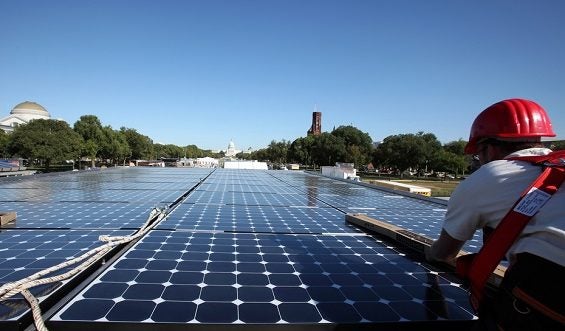Omnibus bill veto saves community solar

A picture may be worth a thousand words, but recently the removal of one word, “financing”, could have impeded our ability to benefit from solar through community solar. The removal of this word was tucked away in a bill passed through the legislature. Fortunately, Governor Dayton vetoed the bill. To understand why this one word could have had such a large impact on community solar access, it’s necessary to understand how Minnesota’s community solar program values the electricity these solar projects generate.
When Xcel Energy’s Solar*Rewards community program began, community solar subscribers received bill credits at what was called the “applicable retail rate” (ARR). This rate included all charges (customer, energy, distribution, and transmission) as well as renewable energy credit. For residential subscribers, this could be 12-15 cents per kilowatt-hour (kWh). This rate was more than the typical Xcel Energy customer paid per kWh for electricity (about 11 cents per kWh). So, community solar subscribers received a bill credit that was greater than what they paid for the electricity they used from Xcel Energy.
There are good reasons for community solar customers to receive a higher credit for the electricity they use from community solar than what they pay for electricity from the utility. Community solar can provide electricity closer to the source of demand, meaning there is less wear on electric grid infrastructure that is used by all consumers. Community solar also produces energy from a clean source, which provides health benefits to everyone.
The ARR therefore allowed community solar subscribers to see savings on their electricity bills. The credit rate also allowed for community solar developers to offer subscriptions to residential customers, while still covering the higher costs that come with providing community solar service to them. These higher costs include things like customer acquisition, administrative costs, and higher rates of customer turnover. All of the community solar gardens currently in operation, and most of those under construction this year, are operating under the ARR.
Determining the value of solar
Still, this ARR was only a rough estimate of how electricity from community solar should be valued. In 2014, the Minnesota Department of Commerce completed its stakeholder process to determine the Value of Solar (VOS) in the state. The VOS rate is meant to represent the value of the electricity that is produced by the solar array to the grid, and therefore to be a more accurate compensation value than the ARR.
Its calculation takes into account the avoided costs that Xcel Energy will not have to incur due to the presence of the solar electricity, such as environmental costs, generation capacity, and fuel costs. Xcel Energy provides the data to the Department of Commerce for calculation, and much of the data are trade secret.
The most recent VOS calculation levelized over 25 years is 12.4 cents, but adjusting for inflation, the 2018 value is about 10 cents per kWh. This is below the residential cost of electricity. Since community solar subscribers typically join to save money off their electricity bill, few developers could offer residential subscriptions under the VOS rate because these customers would be better off financially if they stuck with their utility.
Why is the VOS lower than the current cost of electricity? Part of the reason is that the avoided fuel costs are tied to the cost of natural gas, which has been remarkably low in recent years. Another factor is that Minnesota has no REC market, so there is no additional value there. Advocates also argue that Xcel Energy has underestimated the “localized benefits” (savings that come from generating electricity close to the spot where it will be used) and the avoided cost of system upgrades.
Protecting community solar
To counter this problem, solar advocates pushed for an additional credit to the VOS rate for residential subscribers, a “residential adder”. The Public Utilities Commission is currently considering whether a residential adder is necessary for the program. In the current community solar statute, the language requires the Public Utilities Commission to create a community solar program that “reasonably allow(s) for the creation, financing, and accessibility of community solar gardens” (Minn. Stat. § 216B.1641, emphasis added). This is where the Legislature sought to remove “financing” from consideration.
The Commission has looked at the inclusion of the word financing as ensuring that developers can reasonably cover the costs of developing these gardens, while including residential subscribers as well as commercial. Without any residential adder, community solar developers would be incentivized to find as few subscribers as necessary. This would push out residential subscribers. Residential subscribers are more expensive to service. Their subscriptions are typically much smaller than commercial or industrial subscribers. And, residential subscribers would not see energy bill savings with the VOS rate alone, so they’d be less likely to be interested in a subscription.
If the financeability requirement had been removed, the Commission may have had less incentive to consider a residential adder for the community solar program. Now we watch to see what the Commission decides!
For more on this topic, check out:
https://ilsr.org/supporting-affordable-residential-access-to-community-solar-in-minnesota/
https://energynews.us/2018/05/24/midwest/minnesota-may-ease-transition-to-new-community-solar-rates/
